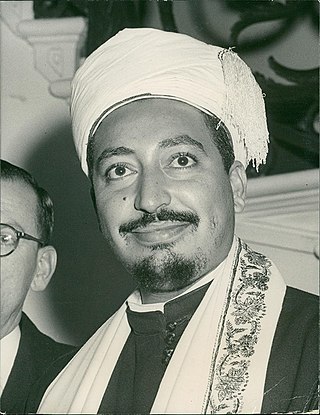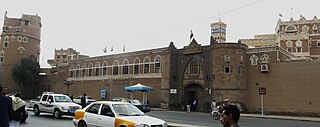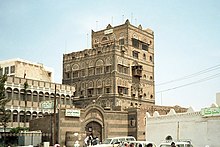
The history of Yemen describes the cultures, events, and peoples of what is one of the oldest centers of civilization in the Near East. Its relatively fertile land and adequate rainfall in a moister climate helped sustain a stable population, a feature recognized by the ancient Greek geographer Ptolemy, who described Yemen as Eudaimon Arabia meaning "fortunate Arabia" or "Happy Arabia". Yemenis had developed the South Arabian alphabet by the 12th to 8th centuries BC, which explains why most historians date all of the ancient Yemeni kingdoms to that era.

The Armed Forces of Yemen are the military forces of the Republic of Yemen. They include the Yemeni Army, Yemeni Navy and the Yemeni Air Force. The capital of the country, Sana’a is where the military is headquartered. Per the constitution of Yemen, the President of Yemen serves as the commander-in-chief.

The Egyptian Museum in Cairo, commonly known as simply the Egyptian Museum, located in Cairo, Egypt, houses the largest collection of Egyptian antiquities in the world. It houses over 120,000 items, with a representative amount on display. Located in a building built in 1901, it is the largest museum in Africa. Among its masterpieces are Pharaoh Tutankhamun's treasure, including its iconic gold burial mask, widely considered one of the best-known works of art in the world and a prominent symbol of ancient Egypt.

Yemen, officially the Republic of Yemen, is a country in West Asia. It is located in the southern end of the Arabian Peninsula, and borders Saudi Arabia to the north and Oman to the northeast. It shares maritime borders with Eritrea, Djibouti and Somalia. Covering 555,000 square kilometres and having a coastline of approximately 2,000 kilometres, Yemen is the second-largest Arab sovereign state on the Arabian Peninsula. Sanaa is its constitutionally stated capital and largest city. The country's population is estimated to be 34.4 million as of 2023. Yemen is a member of the Arab League, the United Nations, the Non-Aligned Movement and the Organisation of Islamic Cooperation.

Seiyun is a city in the region and Governorate of Hadhramaut in Yemen. It is located in the middle of the Hadhramaut Valley, about 360 km (220 mi) from Mukalla, the capital of Mukalla District and the largest city in the area, via western route. It is also 12 km (7.5 mi) away from Shibam and 35 km (22 mi) away from Tarim, other large cities in the valley.

Ibb is a city in Yemen, the capital of Ibb Governorate, located about 117 km (73 mi) northeast of Mocha and 194 km (121 mi) south of Sana'a. A market town and administrative centre developed during the Ottoman Empire, it is one of the most important medium-sized cities in the country. It is situated on a mountain ridge, surrounded by fertile land. As of 2023, it has an estimated population of 771,500 residents.

Muhammad Al-Badr was the last king and Zaidi Imam of the Mutawakkilite Kingdom of Yemen and leader of the monarchist regions during the North Yemen Civil War (1962–1970). His full name was Al-Mansur Bi'llah Muhammad Al-Badr bin Al-Nasir-li-dinu'llah Ahmad, Imam and Commander of the Faithful and King of the Mutawakkilite Kingdom of the Yemen.

The Istanbul Archaeology Museums are a group of three archaeological museums located in the Eminönü quarter of Istanbul, Turkey, near Gülhane Park and Topkapı Palace.

The National Museum of Damascus is a museum in the heart of Damascus, Syria. As the country's national museum as well as its largest, this museum covers the entire range of Syrian history over a span of over 11 millennia. It displays various important artifacts, relics and major finds most notably from Mari, Ebla and Ugarit, three of Syria's most important ancient archaeological sites. Established in 1919, during King Faisal's Arab Kingdom of Syria, the museum is the oldest cultural heritage institution in Syria.

Sanaa, also spelled Sana'a and Sana, is the capital of Yemen and the largest city of Yemen and the capital of the Sanaa Governorate. The city is not part of the Governorate, but forms the separate administrative district of ʾAmānat al-ʿĀṣimah. According to the Yemeni constitution, Sanaa is the capital of the country, although the seat of the Yemeni government moved to Aden, the former capital of South Yemen in the aftermath of the Houthi occupation. Aden was declared as the temporary capital by then-president Abdrabbuh Mansur Hadi in March 2015.
Ghumdan Palace, also Qasir Ghumdan or Ghamdan Palace, is an ancient palace and fortress in Sana'a, Yemen. It is the earliest known castle in the world. All that remains of the ancient site of Ghumdan is a field of tangled ruins opposite the first and second of the eastern doors of the Jami‘ Mosque. This part of Sana'a forms an eminence which is known to contain the debris of ancient times. The place is located on the extreme southeastern end of Sana'a's old walled city, al-Qaṣr, just west of where the Great Mosque of Sana'a was later built, and is part of the UNESCO World Heritage Site of the Old City of Sana'a. It is sometimes referred to as Ghumdan Tower.

The Great Mosque of Sana'a is an ancient mosque in Sana'a, Yemen, and one of the oldest mosques in the world. The mosque is said to have been founded in the early Islamic period, suggested to be in 633. While the precise date of construction is unknown, the earliest recorded renovations occurred under Caliph al-Walid I in the early 8th century, implying a possible earlier date of construction. The mosque was reportedly built in part from spolia from the Himyarite-era Ghumdan Palace and from the Axumite Christian Church of al-Qalis that formerly occupied the site. The Great Mosque is the largest and most notable of over one hundred mosques in the Old City of Sana’a.


The Dar al-Hajar is a former royal palace located in Wadi Dhar about 15 kilometres (9.3 mi) from Sana'a, Yemen. Built in the 1920 as the summer retreat of Yahya Muhammad Hamid ed-Din, ruler of Yemen from 1904 to 1948, it sits on top of a structure built in 1786 for the scholar al-Imam Mansour. The palace stayed in the royal family until the Yemen revolution of 1962. The palace is now a museum. In 1974, Pier Paolo Pasolini used the palace as the home of Princess Dunya in his film The Arabian Nights.
Dar al-Bashair is a royal palace located in the Bir al-Azab district of Sana'a, Yemen.

Dar al-Shukr is a royal palace located in Sana'a, Yemen. It is located near Qubbat al-Mutawakkil Mosque dome in Tahrir Square in the city centre.

Dar as-Sa'd, also written Dar Al-Sada , is a royal palace located in Sana'a, Yemen. It is located near Qubbat al-Mutawakkil Mosque dome in Tahrir Square in the city centre.
The following is a timeline of the history of the city of Sana'a, Yemen.

Carl August Rathjens was a German geographer whose primary interests were in South Arabian historiography, geology and ethnography. He made several visits to Yemen, in the years 1927, 1931, 1934 and 1938. He is considered the greatest scholar of Yemeni research in the 20th century. He contributed more than any other in conducting scientific and ethnographic research, resulting in a wide range of findings, and he has left over 2500 ethnographical items and some 4000 positive and negative photographs from South Arabia.

The Yemen Gate or Gate of Yemen is the main gate of Sana's old fortified wall, on the southern extremity of the walled city. Its current appearance dates to the 17th century, having been designed by Sam the son of Noah. Today, it is the most ornate of the gates of Sana's Old City. Passengers travelling southward, en route to Ma'bar and Dhamar, would depart from this gate.




















